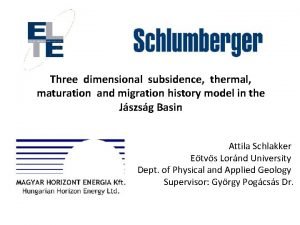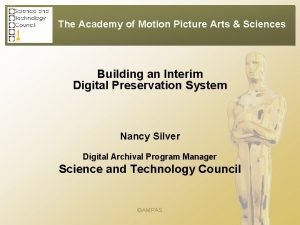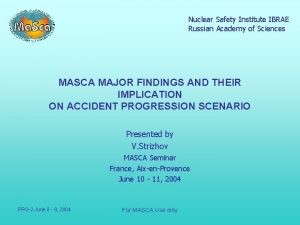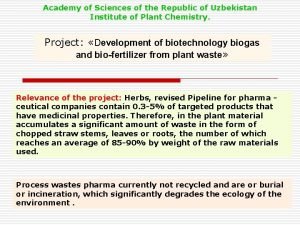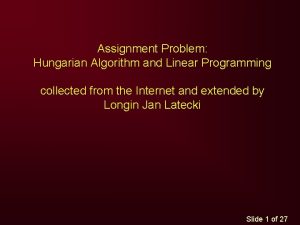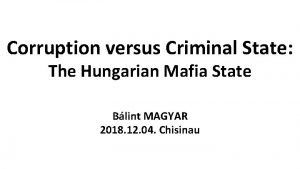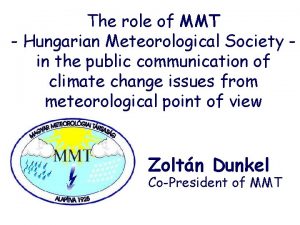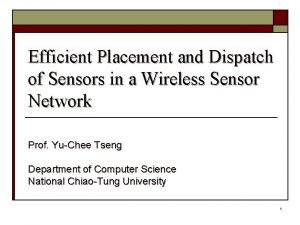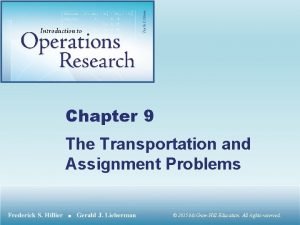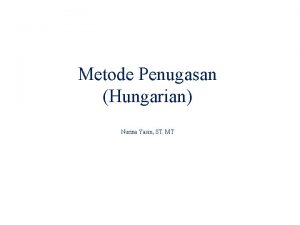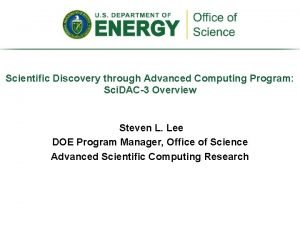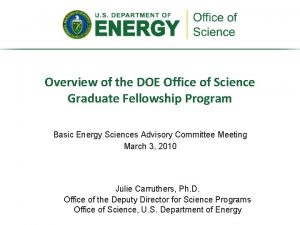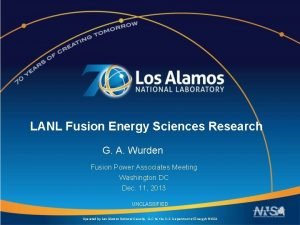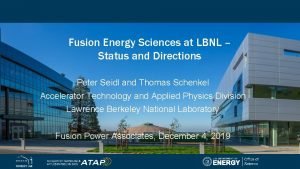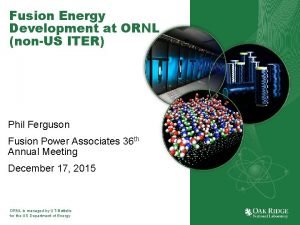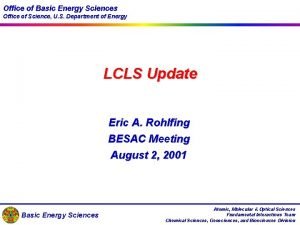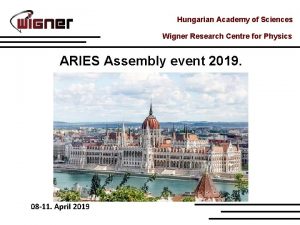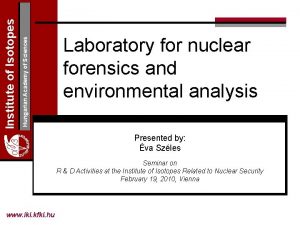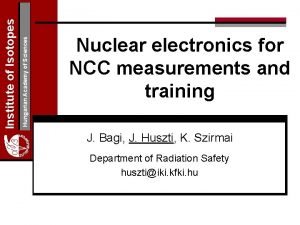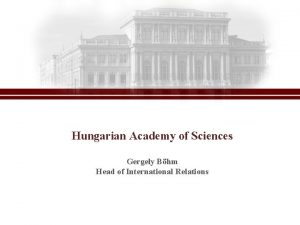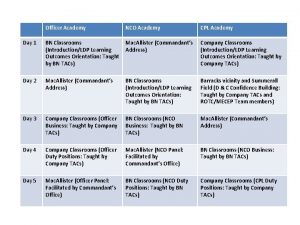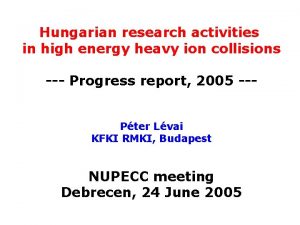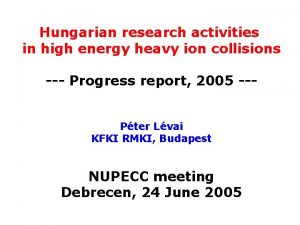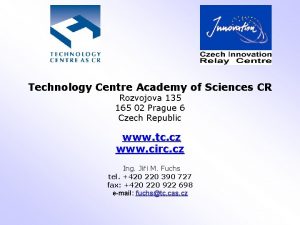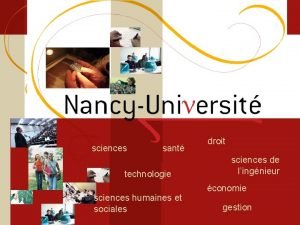Centre for Energy Research Hungarian Academy of Sciences




















































- Slides: 52

Centre for Energy Research, Hungarian Academy of Sciences Concepts of Renewable Energy Integration: Smart Grid Janos Sebestyen JANOSY Senior Scientific Advisor

Centre for Energy Research, Hungarian Academy of Sciences AMS 2016 Kota Kinabalu 5 th of Dec. 2016 2

Centre for Energy Research, Hungarian Academy of Sciences AMS 2016 Kota Kinabalu 5 th of Dec. 2016 3

Centre for Energy Research, Hungarian Academy of Sciences AMS 2016 Kota Kinabalu 5 th of Dec. 2016 4

Centre for Energy Research, Hungarian Academy of Sciences Contents Part I: Network architectures Part II: A traditional power grid (Hungarian) Part III: State-of-art up-to-date power grid (Smartgrid) Part IV: The key: Storage of electrical energy (new achievements) AMS 2016 Kota Kinabalu 5 th of Dec. 2016 5

Centre for Energy Research, Hungarian Academy of Sciences Part I: Network Architectures Tradition in urbanized areas (Description: directed and undirected graphs) Centralized networks: 1. Water supply (tower at center) 2. Electrical grid (Power plant, distributor) 3. Gas supply (Pipelines - distributors) 4. Wired phone (Switching center) AMS 2016 Kota Kinabalu 5 th of Dec. 2016 6

Centre for Energy Research, Hungarian Academy of Sciences Centralized networks: the „last kilometer – last mile” problem Problem with the property owners Montage techniques Metering of the provided services Diversion protection Uneven cultural level of the customers Maintenance and servicing problems AMS 2016 Kota Kinabalu 5 th of Dec. 2016 7

Centre for Energy Research, Hungarian Academy of Sciences Switchboard in the phone switching centre AMS 2016 Kota Kinabalu 5 th of Dec. 2016 8

Centre for Energy Research, Hungarian Academy of Sciences “Last mile” problems I. AMS 2016 Kota Kinabalu 5 th of Dec. 2016 9

Centre for Energy Research, Hungarian Academy of Sciences AMS 2016 Kota Kinabalu 5 th of Dec. 2016 10

Centre for Energy Research, Hungarian Academy of Sciences “Last mile” service problems AMS 2016 Kota Kinabalu 5 th of Dec. 2016 11

Centre for Energy Research, Hungarian Academy of Sciences Network types As it is in Hungary Highest level: „Mesh” Local level: „Tree” AMS 2016 Kota Kinabalu 5 th of Dec. 2016 12

Centre for Energy Research, Hungarian Academy of Sciences What are the requirements? 1. Distributed, not centralized: at least partially self-reliant 2. Redundancy – we have spare for every part of it 3. Diversity – we can arrange the same result in different ways (avoiding common-mode failures) 4. Hierarchical structures – separation of the levels of different functions (The pyramid of the severity) 5. Defense-in-depth – should not “collapse”: self-checking, self-testing, self-healing, stepwise degradation: remaining fraction should be “standing alive” AMS 2016 Kota Kinabalu 5 th of Dec. 2016 13

Centre for Energy Research, Hungarian Academy of Sciences The most reliable networks: „ad-hoc” networks Up-to-date processing technology: It takes 6 magnitude (!) less energy to process a byte locally than to transfer it somewhere else. That means to minimize the data transfer, to compress the information and to transfer only the data changes when they are already significant. Each node should be intelligent and capable to fulfill all necessary network function (connecting, routing, transferring data, etc. ) Each node is connected only to its neighbors but removes connection with a remote node only in case if it has enough local connection. (Each node is able to perform all functions!) There is no pre-defined structure and functions; authorization is of vital importance (in order to avoid diversion) AMS 2016 Kota Kinabalu 5 th of Dec. 2016 14

Centre for Energy Research, Hungarian Academy of Sciences Part II: Traditional power grid XIX. Century, the Technical Revolution: Based totally on steam power Studying the behavior of expanding gases - all this is gained by designing and testing RIFLES, GUNS! (internal combustion engines - pressure dynamics) Requires knowledge of thermo-hydraulics The power of the steam engine was introduced v Steam engine is more powerful than anything else v Manufacture is replaced by factory v Steam engine is hot, wet, noisy – usually it is located outside AMS 2016 Kota Kinabalu 5 th of Dec. 2016 15

Centre for Energy Research, Hungarian Academy of Sciences Price of electrical power: What means 1 k. Wh? Physical work: 1 k. Wh: 1 k. W * 1 h = 1 k. W * 3600 s 1 k. W: 1000 Nm/s = 98. 1 kpm/s Lifts appr. 100 kg each second during an hour to the height of 1 m - that means 3600 times Equivalent to: Lifting 250 cars (1440 kg each) to the height of 1 m (like in the car service startion) - Price: 10 eurocents, appr. 30 HUF!! AMS 2016 Kota Kinabalu 5 th of Dec. 2016 16

Centre for Energy Research, Hungarian Academy of Sciences Energy: Basis for technical revolution Example: Hungary Per capita consumed power: v 4250 MWe, 10 million people: v 425 W contunuously for every person! Family of four: 1700 W continuously, 7 days - 24 hours This means: lifting continuously 170 kg to 1 m height each second CONTINUOUSLY! Add to this energy: the horsepower of your car, the heating of your house. . . AMS 2016 Kota Kinabalu 5 th of Dec. 2016 17

Centre for Energy Research, Hungarian Academy of Sciences Steam Engine I. AMS 2016 Kota Kinabalu 5 th of Dec. 2016 18

Centre for Energy Research, Hungarian Academy of Sciences Factory I. AMS 2016 Kota Kinabalu 5 th of Dec. 2016 19

Centre for Energy Research, Hungarian Academy of Sciences Factory II. AMS 2016 Kota Kinabalu 5 th of Dec. 2016 20

Centre for Energy Research, Hungarian Academy of Sciences Factory III. AMS 2016 Kota Kinabalu 5 th of Dec. 2016 21

Centre for Energy Research, Hungarian Academy of Sciences Nothing important has been changed since the end of XIX century! § Power generation is concentrated to power plants § Instead of line shafts and transmission belts electricity is used (more convenient but provides the same rigid connection between the rotating axles) § The supply and demand is fitted not by rotation number but frequency of alternating current - it is the same, frequency is determined by the rotation number of the generators synchronized together § Still there is no energy storage in the system – only the mechanical energy is stored by the inertia of the rotors of generators and electrical drives AMS 2016 Kota Kinabalu 5 th of Dec. 2016 22

Centre for Energy Research, Hungarian Academy of Sciences Alternating Current (AC): essential To avoid losses during transport we have first to increase the voltage (at destination to decrease the voltage) Transformer (only for AC): Miksa Déri , Ottó Titusz Bláthy és Károly Zipernowsky : 1885 The network can be controlled by means of frequency control: If the frequency (i. e. the rotation number) decreases, then: § steam engines increase power § electrical drives (consumers) decrease power The inertia of the rotors slows down the control transients AMS 2016 Kota Kinabalu 5 th of Dec. 2016 23

Centre for Energy Research, Hungarian Academy of Sciences The actual Hungarian network: “Mesh” upper level AMS 2016 Kota Kinabalu 5 th of Dec. 2016 24

Centre for Energy Research, Hungarian Academy of Sciences Frequency control I. AMS 2016 Kota Kinabalu 5 th of Dec. 2016 25

Centre for Energy Research, Hungarian Academy of Sciences Frequency control I. AMS 2016 Kota Kinabalu 5 th of Dec. 2016 26

Centre for Energy Research, Hungarian Academy of Sciences Perspective: Direct Current (DC) The power consumed by many appliances do not depend on frequency any more (switching power supplies, IT technology, etc. ) AC cannot be transported very far if the power is very high (different losses, specific to AC) The solution in this case: Direct Current (DC) – it is expensive: To avoid high voltage superconductors are needed (liquid nitrogen cooling), high conversion costs, AC transformers are useless, it has to be buried, etc. AMS 2016 Kota Kinabalu 5 th of Dec. 2016 27

Centre for Energy Research, Hungarian Academy of Sciences Part III: „Smart Grid” Now in Hungary: v Grid since 2007 already accepts supplies below 500 k. W v Coarse control actions (switching off customers) v Does not encourage intelligent consumption (fixed prices!) v the Bláthy-type electro-mechanical metering is outdated (one-way flow of energy, and sinusoidal currents only) More and more non-sinusoidal and frequency-independent loads (switching power supplies, economic fluorescent light bulbs, etc. ) Actual meters are not correct if the current is not sinusoidal! AMS 2016 Kota Kinabalu 5 th of Dec. 2016 28

Centre for Energy Research, Hungarian Academy of Sciences Power plants, National power grid, External connections Local Service Providers As it is now: Grid Control room Informatics Communication Consumers of the electrical energy v Watt-hour meter (invented in 1889) v Unlimited consumption at fixed price (usually) v Not part of the grid control AMS 2016 Kota Kinabalu 5 th of Dec. 2016 29

Centre for Energy Research, Hungarian Academy of Sciences Traditional grid AMS 2016 Kota Kinabalu 5 th of Dec. 2016 30

Centre for Energy Research, Hungarian Academy of Sciences What are the requirements? v Safety first: we think differently after Sept. 11, 2001 v No more long blackouts like in 2003 at the US east coast v Networks: we are accustomed to redundant, diverse, hierarchical, protected in depth networks in the IT technology. They are: v Distributed, scalable, degradable in steps, self-diagnosing, selfhealing networks: capable to operate in a degraded and reduced form too v There should be „Stand-alone” mode as well: based on local production and storage in a reduced form (only small power is available for mobile phones, Internet, TV, probably the deepfreezer) v The excess energy should be accepted by the network and transferred to other users actually lacking energy AMS 2016 Kota Kinabalu 5 th of Dec. 2016 31

Centre for Energy Research, Hungarian Academy of Sciences Contradiction: sequential energy flow, distributed information flow AMS 2016 Kota Kinabalu 5 th of Dec. 2016 32

Centre for Energy Research, Hungarian Academy of Sciences Indispensable: intelligent metering of consumption Tasks: v correct energy metering of any current form in both direction v tariffs in both direction can be changed in every 5 -10 minutes (internet or other connection with the service providers) v consumption is measured in currency instead of k. W-hours according to the actual tariffs for both direction v Wi. Fi, USB connection with the local (home) computer in order to inform about the actual tariffs v local computer actuates the local reserve supply automatically and in a synchronized way in case of power grid failure v If the power grid is recovered the switch-back should be automatic and smooth AMS 2016 Kota Kinabalu 5 th of Dec. 2016 33

Centre for Energy Research, Hungarian Academy of Sciences Intelligent home of the future First step: Intelligent metering Anything else only after that AMS 2016 Kota Kinabalu 5 th of Dec. 2016 34

Centre for Energy Research, Hungarian Academy of Sciences Connection to the traditional grid AMS 2016 Kota Kinabalu 5 th of Dec. 2016 35

Centre for Energy Research, Hungarian Academy of Sciences Extreme advantage: Consumer participates in grid control! Now, if we loose one of the power plants, we have to import or switch off some customers. If the tariff is flexible, due the rising prices the intelligent customers switch off the less necessary big loads – tariff takes over gradually the control with the frequency Control strategy: to avoid oscillation (high price – switch off; lower price – switch back: causes instability – Simulation studies! Price-dependent control enhances the peak/average ratio, better exploit of the capacities, less power changes increase the efficiency of the power plants, lower the exhaustion of equipment (less variation of the parameters) First step is not so difficult: distributors should be replaced by Blue. Tooth-controlled ones to switch off/on loads by the computer; AMS 2016 Kota Kinabalu 5 th of Dec. 2016 36

Centre for Energy Research, Hungarian Academy of Sciences How to proceed? It is not easy to fit into an existing power grid. A living area, a neighborhood, village etc. can form an internal grid adding up consumption, production and storage. It is cheaper this way and the control is easier. Significant volume and capacity can be connected to the national grid in a competitive way. The laws are to be adjusted to promote these activities. There are several experimental facilities trying to be competitive this way – mostly universities, campuses organized this way in Budapest, Hungary. Underdeveloped areas without existing power grids (Australia, Argentina, Indonesia (Sarawak) are free to start with smart local energy systems. Interesting: sun and wind power are supplementing each other (Inverted U and V type daily production) AMS 2016 Kota Kinabalu 5 th of Dec. 2016 37

Centre for Energy Research, Hungarian Academy of Sciences Still frequency control with small-scale storage AMS 2016 Kota Kinabalu 5 th of Dec. 2016 38

Centre for Energy Research, Hungarian Academy of Sciences The European Dream. . . everything is integrated. . . AMS 2016 Kota Kinabalu 5 th of Dec. 2016 39

Centre for Energy Research, Hungarian Academy of Sciences Part IV: Storage of electrical energy “A next-generation smart grid without energy storage is like a computer without a hard drive: severely limited. ” - Katie Fehrenbacher, Giga. Om According to market research firm IHS, the energy storage market is set to “explode” to an — annual installation size of 6 gigawatts (GW) in 2017 — and over 40 GW by 2022 from an initial base of only — 0. 34 GW installed in 2012 and 2013. AMS 2016 Kota Kinabalu 5 th of Dec. 2016 40

Centre for Energy Research, Hungarian Academy of Sciences Storage of electrical energy Usually we store the SOURCE of the electrical energy (gas, oil, coal, nuclear fuel element, etc. ) The biggest problem of the unpredictable renewable energy sources: Not only they are expensive but there should be enough traditional power plant capacity in “stand-by” mode to take over whenever it is necessary – costs of amortization, staff, non-optimal operation We should learn to store enough energy to “smooth” the production! The cheapest and most reliable way the water-pumping power plant. Storage of the electrical energy in a safe and economic way in big quantities is not fully solved yet. But any new technology is expensive at the beginning. . . It is really very necessary: it will be solved sooner or later. It is INDISPENSABLE! AMS 2016 Kota Kinabalu 5 th of Dec. 2016 41

Centre for Energy Research, Hungarian Academy of Sciences „Environment-friendly” energy sources Accumulators (batteries): to use them is clean, to produce and to dismantle them is not. Source of the charging current? May be it is produced by a coal-firing plant? ! Photovoltaic cells: the same. Pollution during production and demolition. “Not emitting CO 2”: Nuclear power plants are definitely do not when operating. But construction? Production of big steel vessels? Spare parts? Transportation and management of the wastes? Something is emitted even if not so much. WE HAVE TO THINK GLOBALLY. We should not be “deep greens”: just chanting slogans - not thinking them over. AMS 2016 Kota Kinabalu 5 th of Dec. 2016 42

Centre for Energy Research, Hungarian Academy of Sciences Raccoon Mountain: http: //www. tva. gov/sites/raccoonmt. htm Efficiency of the water pumping plants can reach 90%. The efficiency of the best accumulatorbatteries: below 70% AMS 2016 Kota Kinabalu 5 th of Dec. 2016 43

Centre for Energy Research, Hungarian Academy of Sciences Embedded, latent energy storage at home Excellent thermo-isolation of the home: § less heat losses, less heating and cooling is necessary § The ratio of the stored heat/lost heat is greater, the heating can be switched off for a longer period of time, which is in fact storage The same is true for refrigerators and deep freezers – they should be well isolated and large (less surface for the same volume means better thermo-isolation), one large is better than two smalls The remaining power of the electric car (after coming home): It can be used to cover the evening energy needs of the house (during the peak loads). Cheap recharging may start only after midnight using the cheap electricity of the small hours. . . AMS 2016 Kota Kinabalu 5 th of Dec. 2016 44

Centre for Energy Research, Hungarian Academy of Sciences Practical usage of super-capacitors AMS 2016 Kota Kinabalu 5 th of Dec. 2016 45

Centre for Energy Research, Hungarian Academy of Sciences Szuperkondenzátorok gyakorlati alkalmazása AMS 2016 Kota Kinabalu 5 th of Dec. 2016 46

Centre for Energy Research, Hungarian Academy of Sciences Na. S battery – the best in everything so far Working temperature: min. 290 C AMS 2016 Kota Kinabalu 5 th of Dec. 2016 47

Centre for Energy Research, Hungarian Academy of Sciences Data sheet for a Na. S battery They are efficient if produced of big sizes and capacity. The one in the Hitachi factory (wafer production, semiconductors): Power: 8 MW Capacity: Partial discharge cycles: Full discharge cycles: 57, 6 MWh 4, 500 times 2, 500 times Lifetime: Efficiency at least 15 years at least 76% (!) up to 89 -90% Manufacturing, installation: 3 months AMS 2016 Kota Kinabalu 5 th of Dec. 2016 (for more than 7 hours) (if up to 90% only) (up to 100%) (recovered energy) (Pb batteries never reach 70% 48

Centre for Energy Research, Hungarian Academy of Sciences Gyakorlati megvalósítás – már kapható AMS 2016 Kota Kinabalu 5 th of Dec. 2016 49

Centre for Energy Research, Hungarian Academy of Sciences Na. S Sodium-Sulfur batteries: Na. S battery technology has been demonstrated at over 190 sites in Japan. More than 270 MW of power (generated from stored energy) suitable for 6 hours of daily peak shaving have been installed. The largest Na. S installation is a 34 -MW, 245 -MWh unit for wind stabilization in Northern Japan. AMS 2016 Kota Kinabalu 5 th of Dec. 2016 50

Centre for Energy Research, Hungarian Academy of Sciences Conclusions: We should not consume electrical energy as we did in the 1890 s. We are too many on the Earth for that. During the changes we should not remain without electricity, not for a minute. There is a lot of creative engineering effort necessary. Everything in this industry is expensive – a lot of creative MODELING AND SIMULATION will be necessary! (It’s a pity that I am not young enough to change profession. . . ) AMS 2016 Kota Kinabalu 5 th of Dec. 2016 51

Centre for Energy Research, Hungarian Academy of Sciences Thank you for your attention! Questions? AMS 2016 Kota Kinabalu 5 th of Dec. 2016 52
 Hungarian horizon energy
Hungarian horizon energy Human sciences tok
Human sciences tok Hazleton area academy of sciences
Hazleton area academy of sciences Academy of motion picture arts and sciences benefits
Academy of motion picture arts and sciences benefits Nars railroad
Nars railroad Hawaii academy of arts and sciences
Hawaii academy of arts and sciences Putnam academy
Putnam academy Nuclear safety institute of the russian academy of sciences
Nuclear safety institute of the russian academy of sciences Biogas disadvantages
Biogas disadvantages National academy of sciences forensic science
National academy of sciences forensic science Academy of medical sciences multimorbidity
Academy of medical sciences multimorbidity Cleveland arts & social sciences academy
Cleveland arts & social sciences academy Difference between centre of mass and centre of gravity
Difference between centre of mass and centre of gravity Centre of gravity of different shapes
Centre of gravity of different shapes Traditional hungarian clothing
Traditional hungarian clothing Hungarian method
Hungarian method Typical hungarian breakfast
Typical hungarian breakfast Hungarian mundi
Hungarian mundi Hungarian folk tales
Hungarian folk tales Hungarian method linear programming
Hungarian method linear programming Hungarian chamber of agriculture
Hungarian chamber of agriculture Hungarian mafia
Hungarian mafia Contoh soal metode penugasan
Contoh soal metode penugasan Hunspace
Hunspace Hungarian castles
Hungarian castles Compiling vs interpreting
Compiling vs interpreting Hungarian meteorological service
Hungarian meteorological service Hungarian maximum matching algorithm
Hungarian maximum matching algorithm Transportation and assignment problems and solutions
Transportation and assignment problems and solutions Flow diagram homework assignment
Flow diagram homework assignment Metode penugasan
Metode penugasan Lpctstr length
Lpctstr length Hungarian clothing
Hungarian clothing Hungarian o
Hungarian o Hungarian notation vba
Hungarian notation vba Fusion energy sciences
Fusion energy sciences Fusion energy sciences
Fusion energy sciences Doe scgf
Doe scgf Fusion energy sciences
Fusion energy sciences Fusion energy sciences
Fusion energy sciences Fusion energy sciences
Fusion energy sciences Fusion energy sciences
Fusion energy sciences Fusion energy sciences
Fusion energy sciences Office of basic energy sciences
Office of basic energy sciences Energy energy transfer and general energy analysis
Energy energy transfer and general energy analysis Energy energy transfer and general energy analysis
Energy energy transfer and general energy analysis Formuö
Formuö Typiska drag för en novell
Typiska drag för en novell Nationell inriktning för artificiell intelligens
Nationell inriktning för artificiell intelligens Returpilarna
Returpilarna Varför kallas perioden 1918-1939 för mellankrigstiden?
Varför kallas perioden 1918-1939 för mellankrigstiden? En lathund för arbete med kontinuitetshantering
En lathund för arbete med kontinuitetshantering Särskild löneskatt för pensionskostnader
Särskild löneskatt för pensionskostnader
